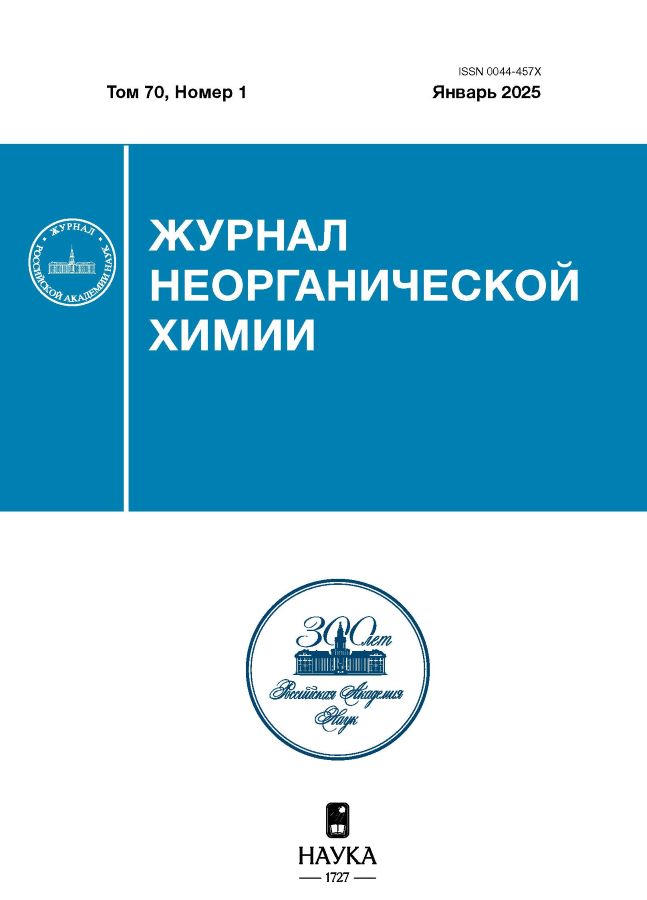Low-temperature synthesis and luminescent properties of lanthanum metaphosphate LaP3O9 : Tb
- Authors: Belobeletskaya M.V.1, Steblevskaya N.I.1, Medkov M.A.1
-
Affiliations:
- Institute of Chemistry of the Far Eastern Branch of the Russian Academy of Sciences
- Issue: Vol 70, No 1 (2025)
- Pages: 26–32
- Section: СИНТЕЗ И СВОЙСТВА НЕОРГАНИЧЕСКИХ СОЕДИНЕНИЙ
- URL: https://rjraap.com/0044-457X/article/view/682186
- DOI: https://doi.org/10.31857/S0044457X25010035
- EDN: https://elibrary.ru/IBBGGT
- ID: 682186
Cite item
Abstract
Promising for inorganic luminophores, terbium-doped lanthanum metaphosphates La1-xTbxP3O9 (x = 0.05, 0.1, 0.2, 0.3, 0.4) were synthesised by extraction-pyrolytic method at low temperature in comparison with known methods. The crystal structure and optical properties of the obtained samples were characterised by X-ray phase analysis, IR and luminescence spectroscopy, and the unit cell parameters were calculated. Сompounds having rhombic structure, pr. gr. C 222 1, were obtained in the temperature range of 500–900°C. All parameters of the unit cell decrease linearly with the introduction of terbium into lanthanum metaphosphate. La1-xTbxP3O9 compounds show intense luminescence in the region of 450–650 nm. The La0.8Tb0.2P3O9 sample obtained in one hour annealing at pyrolysis temperature of 900°C shows maximum luminescence intensity.
Keywords
Full Text
About the authors
M. V. Belobeletskaya
Institute of Chemistry of the Far Eastern Branch of the Russian Academy of Sciences
Author for correspondence.
Email: rita@ich.dvo.ru
Russian Federation, Vladivostok, 690022
N. I. Steblevskaya
Institute of Chemistry of the Far Eastern Branch of the Russian Academy of Sciences
Email: rita@ich.dvo.ru
Russian Federation, Vladivostok, 690022
M. A. Medkov
Institute of Chemistry of the Far Eastern Branch of the Russian Academy of Sciences
Email: rita@ich.dvo.ru
Russian Federation, Vladivostok, 690022
References
- Zhou C., Dong P., Ga P. et al. // Spectrochim. Acta, Part A. 2024. V. 313. P. 124102. https://doi.org/10.1016/j.saa.2024.124102
- Patel L., Mehta M., Sharma R. // IJCRT. 2023. V. 11. № 2. P. 444.
- Возняк-Левушкина В.С., Арапова А.А., Спасский Д.А. и др. // ФТТ. 2022. Т. 64. № 12. С. 1925. https://doi.org/10.21883/FTT.2022.12.53644.449
- Dongyan Y., Xingya W., Gongqin Y. et al. // Mater. Rev. 2020. V. 34. P. 41.
- Барановская В.Б., Карпов Ю.А., Петрова К.В. и др. // Изв. ВУЗов. Цветн. металлургия. 2020. № 6. С. 4. https://doi.org/10.17073/0021-3438-2020-6-4-23
- Седов В.А., Гляделова Я.Б., Асабина Е.А. и др. // Журн. неорган. химии. 2023. T. 68. № 3. С. 291. https://doi.org/10.31857/S0044457X22601602
- Singh V., Ravita Kaur S. et al. // Optik. 2021. V. 244. P. 167323. https://doi.org/10.1016/j.ijleo.2021.167323
- Fang M-H., Bao Z., Huang W-T. et al. // Chem. Rev. 2022. V. 122. № 13. P. 11474. https://doi.org/10.1021/acs.chemrev.1c00952
- Farooq M., Rafiq H., Shah A.I. et al. // ECS J. Solid State Sci. Technol. 2023. V. 12. № 12. P. 126002. https://doi.org/10.1149/2162-8777/ad1062
- Krutyak N., Spassky D., Deyneko D.V. et al. // Dalton Trans. 2022. V. 51. P. 11840.
- Zhang X., Chen P., Wang Z. et al. // Solid State Sci. 2016. V. 58. P. 80. https://doi.org/10.1016/j.solidstatesciences.2016.06.002
- Wang Y., Wang D. // J. Solid State Chem. 2007. V. 180. № 12. P. 3450. https://doi.org/10.1016/j.jssc.2007.10.008
- Kononets N.V., Seminko V.V., Maksimchuk P.O. et al. // Low Temp. Phys. 2017. V. 43. № 8. P. 1009. https://doi.org/10.1063/1.5001311
- Yuan J-L., Zhang H., Zhao J-T. et al. // Opt. Mater. 2008. V. 30. № 9. P. 1369. https://doi.org/10.1016/j.optmat.2007.07.004
- Wu C., Wang Y., Wang D. // Electrochem. Solid-State Lett. 2008. V. 11. № 2. Р. J9. https://doi.org/10.1149/1.2809168
- Briche S., Zambon D., Chadeyron G. et al. // J. Sol-Gel Sci. Technol. 2010. V. 55. P. 41. https://doi.org/10.1007/s10971-010-2211-z
- Onishi T., Hatada N., Kuramitsu A. et al. // J. Cryst. Growth. 2013. V. 380. № 1. P. 78. https://doi.org/10.1016/j.jcrysgro.2013.06.001
- Singh V., Yadav A., Rao A.S. et al. // Optik. 2020. V. 206. P. 164239. https://doi.org/10.1016/j.ijleo.2020.164239
- Hachani S., Moine B., El-akrmi A. et al. // J. Lumin. 2010. V. 130. P. 1774. https://doi.org/10.1016/j.jlumin.2010.04.009
- Yang J., Jia X., Zeng X. et al. // J. Mater. Sci. 2015. V. 50. P. 4405. https://doi.org/10.1007/s10853-015-8996-y
- Стеблевская Н.И., Белобелецкая М.В., Медков М.А. Люминофоры на основе оксидов редких и редкоземельных металлов: экстракционно-пиролитический синтез и свойства. Функциональные керамические и композитные материалы практического назначения: синтез, свойства, применение. Владивосток: Изд-во ВВГУ, 2022. 240 с. https://doi.org/10/12466/0677-0-2022
- Стеблевская Н.И., Белобелецкая М.В. // Хим. технология. 2023. Т. 24. № 1. С. 15.
- Стеблевская Н.И., Белобелецкая М.В. // Журн. неорган. химии. 2023. T. 68. № 7. С. 913. https://doi.org/10.31857/S0044457X22602280
- Matuszewski J., Kropiwnicka J., Znamierowska T. // J. Solid State Chem. 1988. V. 75. P. 285.
- Бугаенко Л.Т., Рябых С.М., Бугаенко А.Л. // Вестн. Моск. ун-та. Сер. 2. Химия. 2008. Т. 49. № 6. С. 363.
- Nakamoto K. Infrared and Raman Spectra of Inorganic and Coordination Compounds: Part A – Theory and Applications in Inorganic Chemistry. N.-Y.: John Wiley and Sons, 2009.
- Blasse G., Grabmaier B.C. Luminescent materials. Berlin: Springer-Verlag, 1994. 233 p.
Supplementary files














